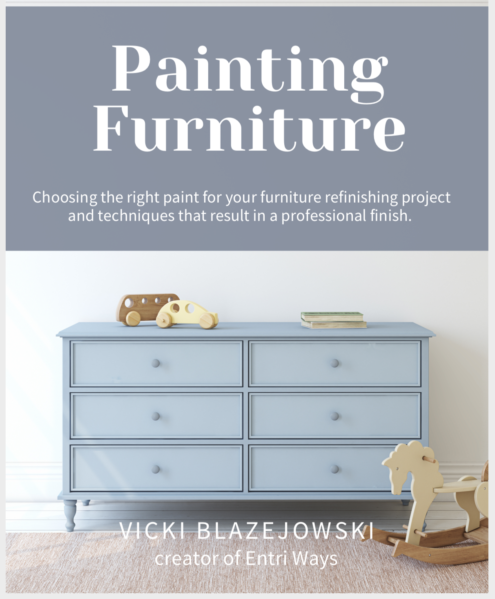Back in early November before the weather here in New England turned too cold to paint and stain, a client (and now friend) ask me to refinish her butcher block table and set of chairs. I’ve refinished a few of these tables and chairs and while they are time-consuming, removing the clear-coat finish from the tabletop is pretty predictable.


Butcher block tables appear to have a very heavy clear-coat on the surface. And the finish is very durable. But in comparison to antique tables I’ve worked on with several thick layers of polyurethane, the finish on butcher block tables actually sands off relatively easy in comparison to those antiques. Here are the supplies you’ll need for the job…
Supplies List
- Craftsman rotary sander
- 60-grit sanding discs
- Minwax water-based gray stain
- General Finishes Winter White Glaze
- Benjamin Moore Stays Clear Low Lustre or Minwax Polycrylic Satin clear-coat
- Valspar Cabinet Enamel white paint
- Benjamin Moore enamel paint in Ashland Slate 1608
- Purdy 1.5-inch clear cut paint brush
- Cotton rags (aka: t-shirts)

As you can see in the photo above, the wood on a butcher block table sands down beautifully. There are so many things you could do with it at this point:
- leave natural and clear-coat with a flat finish
- leave natural and clear-coat for with an oil-based polyurethane
- white-wash with a water-based white stain
- stain with wood tone
- or stain with a water-based color stain
The Chairs
My client preferred the last option and chose a medium gray with a white glaze. We’ll get to the results in a minute. Let’s take a look at the chairs…

Chairs are are ton of work. Sanding the clear-coat from them completely is very difficult, but luckily the enamel paint I use on chairs adheres to even to slick surfaces.
To be safe, I do sand them as much as possible. The areas on the spindles that I cannot reach with the rotary sander get a quick wipe with a sheet of sandpaper to create some tooth. As you can see in the photo below, I was able to remove quite a bit of the clear.


The chairs received 2-3 coats of a dark gray enamel. The color is a Benjamin Moore color called Ashland Slate. It was chosen to coordinate with the water-based Minwax gray stain on the tabletop. We’ll get back to the in a minute.
This paint adheres extremely well and dries and hardens very quickly. If you’d like to learn more about this paint, including how to achieve a smooth finish with it, refer to my ebook: Painting Furniture.

The photo of the chair above actually is very light. The true color of the chairs is more like those below – a dark gray.


The Table Base
The table base first cleaned with Krud Kutter to remove any old dirt and oil. This got the base mostly clean so it really just needed to be touched up. It was painted with Valspar Cabinet enamel paint. I tinted the white paint with a little antique white from my stock to tone down the bright white a bit. The result was a warm winter white.

The Table Top
Now the tabletop…
Minwax makes a water-based stain that can be tinted to a few select colors. Mine was tinted to a medium gray. Two to three coats of the gray stain was wiped on with a clean, cotton rag. Since this stain is water-based, it dries so quickly that I could add two coats, wait an hour, then add the third.
The following day, after the gray stain was completely dry, I wiped on some white glaze to give the top some dimension (per the request of my client).

You can see in the photo below the coffee table in the background that has the same gray stain without the white glaze.
The final step for the tabletop was two coats of a water-based polyurethane. Using a water-based product, means the finish will not yellow like it would with an oil-based product. You can see the low lustre has a slight sheen similar to what was on the original table.

This set is now modern and durable. Here are a few more photos for you…

.


.

Disclosure: This post contains affiliate links to products I use myself.





Leave a Reply